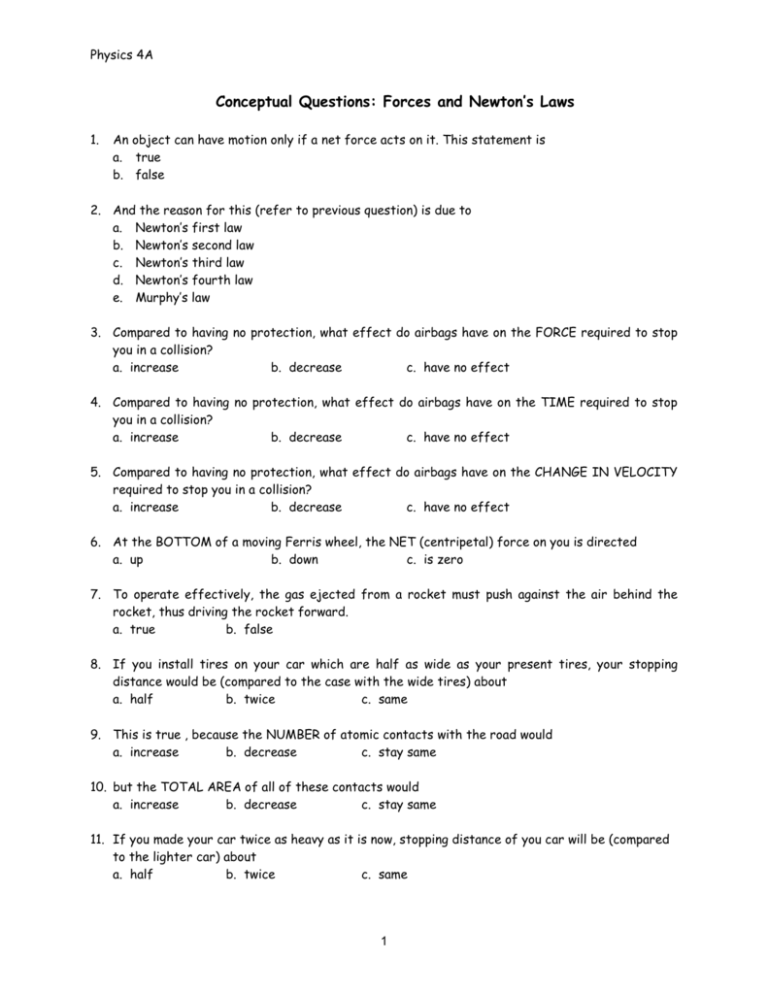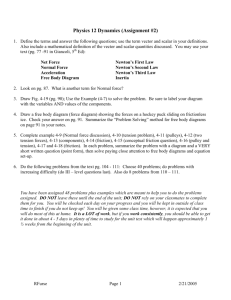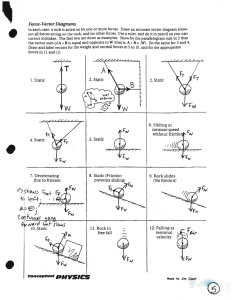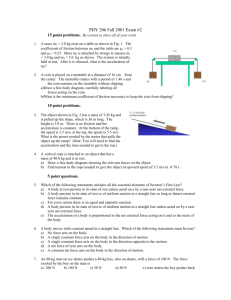2: Conceptual Questions: Forces and Newton's Laws
advertisement

Physics 4A Conceptual Questions: Forces and Newton’s Laws 1. An object can have motion only if a net force acts on it. This statement is a. true b. false 2. And the reason for this (refer to previous question) is due to a. Newton’s first law b. Newton’s second law c. Newton’s third law d. Newton’s fourth law e. Murphy’s law 3. Compared to having no protection, what effect do airbags have on the FORCE required to stop you in a collision? a. increase b. decrease c. have no effect 4. Compared to having no protection, what effect do airbags have on the TIME required to stop you in a collision? a. increase b. decrease c. have no effect 5. Compared to having no protection, what effect do airbags have on the CHANGE IN VELOCITY required to stop you in a collision? a. increase b. decrease c. have no effect 6. At the BOTTOM of a moving Ferris wheel, the NET (centripetal) force on you is directed a. up b. down c. is zero 7. To operate effectively, the gas ejected from a rocket must push against the air behind the rocket, thus driving the rocket forward. a. true b. false 8. If you install tires on your car which are half as wide as your present tires, your stopping distance would be (compared to the case with the wide tires) about a. half b. twice c. same 9. This is true , because the NUMBER of atomic contacts with the road would a. increase b. decrease c. stay same 10. but the TOTAL AREA of all of these contacts would a. increase b. decrease c. stay same 11. If you made your car twice as heavy as it is now, stopping distance of you car will be (compared to the lighter car) about a. half b. twice c. same 1 Physics 4A 12. A brick hits you on your toe (OUCH!). The greater force of impact will be on a. the brick b. your toe c. same force on both d. can’t tell with information given 13. Assume that you weigh 2000 N. If you are falling down through the air at CONSTANT speed, the force of the air against your body is a. zero b. more than 0 but less than 2000 N c. 2000 N d. more than 2000N e. need more info 14. And the NET force on your body is a. zero b. more than 0 but less than 2000 N c. 2000 N d. more than 2000N e. need more info 15. And your acceleration is ------- g’s. a. zero b. more than 0 but less than 1 g d. more than 1 g e. need more info c. 1 g 16. And before you reach constant speed of fall through the air, your acceleration is a. increasing b. decreasing c. not changing 17. Team A beat team B in a game of Tug-O-War. We therefore know that if the winning team pulled on the rope with a force of 10000 N, the losing team pulled on the rope with a force of a. less than 10,000 N b. 10,000 N c. more than 10,000 N d. need more info 18. Also, we know that the ground pushed horizontally against the winning team with a force that is _______ compared to the force of ground against the losing team. a. greater b. same c. less d. need more info to answer 19. Your physics book weighs 40 N. If you drop it on the floor, the force of impact will be a. 40 N b. more than 40 N c. less than 40 N 20. As you round a level curve in your car, you suddenly hit some ice. On the ice, your car will a. veer toward the center of the curve. b. veer away from the center of the curve (in a direction that is opposite to choice a) c. continue in the direction it had when it hit the ice. 21. What force causes you to move forward when you walk? a. The static frictional force of your foot on the sidewalk. b. The static frictional force of the sidewalk on your foot. c. The gravitational force of attraction between your feet and the sidewalk. 22. It a. b. c. is more exhausting to run on sand than on concrete because, The static frictional force is smaller when you walk on sand. The static frictional force is much bigger when you walk on sand. The resistive walking forces are much greater on sand than on concrete. 2 Physics 4A 23. You are standing on a scale in an elevator that is accelerating downward at a constant rate of 1.0m/s2. Your mass is 100kg. You look at the scale to determine your weight, it reads a. 101N b. 880N c. 980N d. 1080N 24. Consider the following scenarios. I. A thrown object at its highest point. II. A hanging mass attached to the top of a moving railroad car that makes a constant angle of 10 degrees with the vertical. III. A bucket that is lowered at a constant velocity. In a. b. c. d. e. which case(s) is the object in dynamic equilibrium? I, II, and III II and III I and III II III 25. A 100g mass is connected to a light string and suspended vertically. It is displaced through an angle and released. The diagrams below indicate the position of the mass at different times t? In which position is the tension in the string greatest? o 90 q A C B a. A b. B c. C 26. As a car moves up a hill, there is a force of friction between the road and the tires rolling on the road. The maximum force of friction is equal to a. the weight of the car times the coefficient of kinetic friction. b. the normal force of the road times the coefficient of kinetic friction. c. the normal force of the road times the coefficient of static friction. d. Zero e. the weight of the car times the coefficient of static friction. 27. For objects moving at nominal speeds, the force of kinetic friction is always equal to mkN, where N is the normal force acting on an object. This statement is a. true b. false 3 Physics 4A 28. An object of mass m rests on a horizontal surface. The coefficient of static and kinetic friction is ms and mk, respectively. The frictional force acting on the object. a. msmg b. mkmg c. 0 29. A student plots a position vs. time graph for a system moving under a constant net force. What will the graph look like? a. Parabola b. Straight (not horizontal) line c. Horizontal line 30. Why do you land with your knees bent when you jump off a tall chair? a. To reduce your change in velocity of your body. b. To increase the interaction time on your bones. c. To increase the stopping force. 31. In which case shown below is the tension in the rope greater? Assume the pulley and string are massless. a. 1 b. 2 c. both are equal 2. 1. 70N 50N 70N Pull 50N 32. A rope is tied to a tree. A student pulls on the rope. A second student decides to pull on the same side of the rope as the first student. If the second student pulls with the same force as the first student the tension in the rope a. halved b. same c. doubled 33. Suppose that the rope in the above problem is untied and the students pull with equal but opposite forces F. As a result, the tension in the rope is a. 0 b. F c. 2F d. 4F 34. If your car goes around a curve too quickly, you seem to be pushed against the door because of a. inertia b. centrifugal force 4 Physics 4A c. friction d. centripetal force 35. Which of the following forces should not be included in a free-body diagram. a. friction b. gravity c. centripetal d. normal 36. A ball is thrown vertically upward with an initial velocity vo. Assume air drag is present. Which of the following is true about its motion? a. Its time of flight upwards is less than its time of flight downwards. b. Its time of flight upwards is greater than its time of flight downwards. c. It takes the same amount of time to go up as it does to come back down. 37. A car starts from rest and accelerates to the right. An inertial observer notices that the pair of dice hanging in the rearview mirror moves a. to the right b. to the left c. answer depends on the magnitude of the car’s acceleration 38. Furthermore, an observer in the reference frame of the car notices that the hanging dice move a. to the right b. to the left c. answer depends on the magnitude of the car’s acceleration 39. The force causing the motion of the hanging dice is caused by a. the force producing the car’s acceleration. b. the tension in the string that supports the dice c. both a and b are correct d. none of the above 40. A block rests in the front end of a trailer. If the trailer accelerates to the right, the block hits the back end of the trailer in t seconds. An inertial observer notices that the block moves a. to the right b. to the left c. answer depends on the magnitude of the trailer’s acceleration 41. The force that causes the motion of the block in the trailer a. the force producing the trailer’s acceleration. b. friction c. both a and b are correct d. none of the above 5 Physics 4A 42. The force of static friction is always equal to msN, where N is the normal force acting on an object. This statement is a. true b. false 43. A skydiver falls through the air. The terminal speed of the skydiver depends on a. his/her spatial orientation b. his/her mass c. the air density d. all of the above 44. A force of F pulls 100 railroad cars of mass m. The net force on the 4th railroad car is a. 0 b. F c. 46F/100 d. 4F/100 e. F/100 45. A mischievous student throws a rock through a school window. One can conclude that greater force of impact was on a. the window b. the rock c. same force on both d. can’t tell with information given The following six figures show various situations where blocks of the same mass m are supported by ropes either with pulleys or fixed objects. We are interested in the rope that is labeled T in each figure. T T T T 30o 2 1 3 T T T 4 5 6 6 Physics 4A 46. In which figure or figures is the tension T the greatest? _________ 47. In which figure or figures is the tension T the least? _________ 48. In which figure or figures is the tension T=mg? _________ 49. Which rope in figure 1 has the greatest tension? a. the one labeled T b. the one below the rope labeled T. 50. A carpenter’s level is shown in the diagram. If the level is pushed to the left, the bubble will move to the Bubble a. to the right Carpenter’s level b. to the left c. answer depends on the magnitude of the car’s acceleration 7






